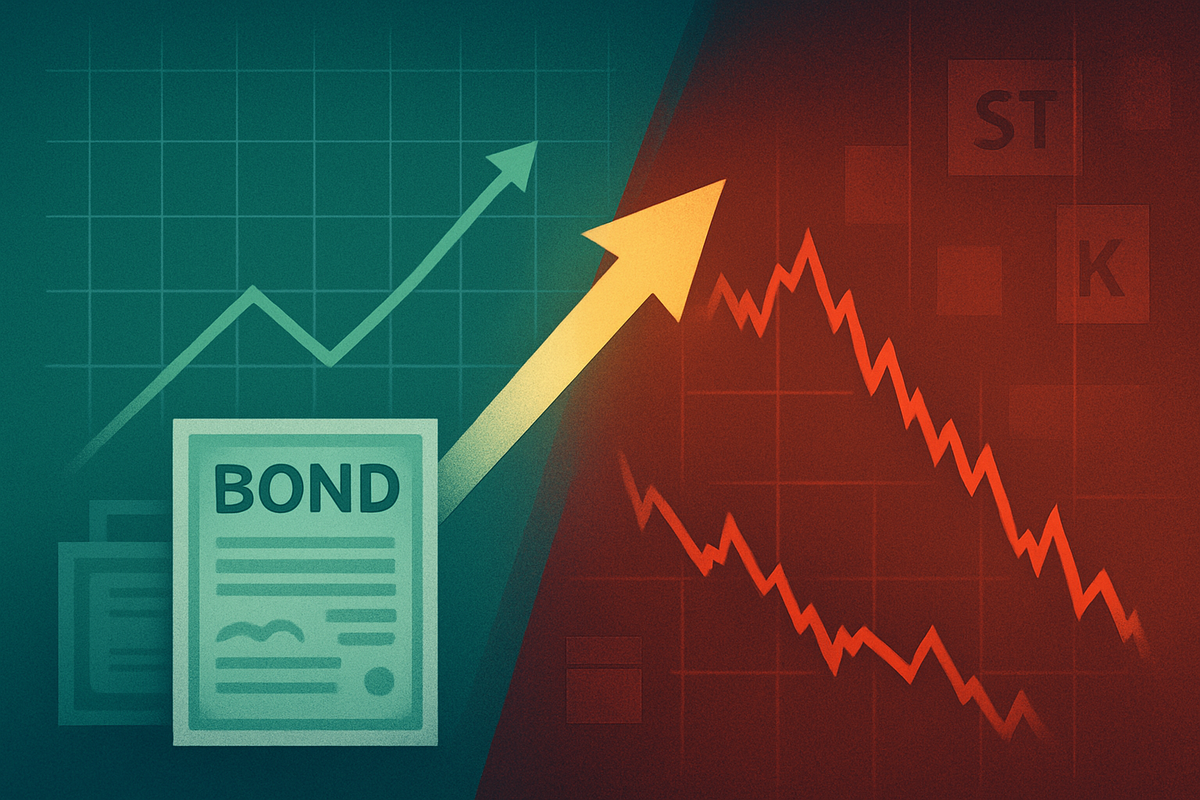
The global bond market is sending increasingly clear and complex signals that warrant close attention from equity investors. As of November 7, 2025, a confluence of factors, including persistent upward pressure on US Treasury yields, a cautious Federal Reserve stance, and a notable increase in corporate credit downgrades, is painting a less sanguine picture for the future direction of equity markets. These trends collectively suggest a potential shift towards a "higher-for-longer" interest rate environment and growing credit risk, which could significantly reshape investment strategies and company valuations.
The immediate implications are multifaceted. Equity valuations, particularly for growth-oriented companies, face downward pressure as higher discount rates erode the present value of future earnings. Furthermore, the burgeoning credit stress within the corporate bond market signals a tightening of financial conditions, potentially leading to increased default risks and reduced profitability for highly leveraged firms. This dynamic forces a re-evaluation of traditional portfolio diversification strategies, as bonds, in this inflationary climate, may offer less protection against equity market downturns than historically observed.
Unpacking the Bond Market's Complex Signals
The current state of the bond market is characterized by several critical developments, driven by a mix of macroeconomic data, central bank rhetoric, and underlying fiscal pressures.
US Treasury yields have recently experienced significant upward pressure and volatility. The 10-year Treasury yield climbed to 4.16% on November 6, its highest in a month, while the 2-year yield also reached a one-month high near 3.63%. This surge is largely attributable to stronger-than-expected labor data, specifically a robust October private payrolls report that tempered expectations for a swift Federal Reserve interest rate cut in December. Further exacerbating this sentiment, Fed Chair Jerome Powell's cautious statements, even after a 25-basis-point rate cut, indicated that a December reduction was "not a foregone conclusion." Additionally, ongoing US fiscal concerns, including potential government refunds from tariffs, could worsen the US fiscal outlook and contribute to higher Treasury yields. Despite these increases, some analysts foresee a decline in yields, with the 10-year yield potentially reaching 3.75% by June 2026, as the Fed is still expected to implement gradual rate cuts. The US Treasury (UST) is also strategically managing its debt, favoring short-term bills over longer-term notes to fund the deficit.
Across the Atlantic, UK Gilt yields present a mixed picture. The UK 10-year Gilt yield rose to 4.47% on November 7, though it had seen a significant monthly drop prior to this. The Bank of England's (BOE) decision to hold rates at 4% was a narrow 5:4 vote, with a substantial dovish contingent favoring a cut. This initially led to a marginal drop in gilt yields. However, persistent inflation in specific sectors and ongoing fiscal pressures in the UK could keep long-term yields elevated, mirroring some of the challenges faced by the US.
Perhaps one of the most stark warnings emanating from the bond market is the increasing credit stress within the corporate sector. Approximately $42 billion of US corporate bonds have been downgraded from investment grade to "junk" status in 2025, marking the highest total in a decade. This signals deteriorating credit conditions, with higher borrowing costs squeezing profit margins and raising concerns about a potential corporate debt crisis. Conversely, the bond market for major technology companies, especially those heavily invested in Artificial Intelligence (AI), shows remarkable resilience. Recent large offerings, such as Meta Platforms' (NASDAQ: META) $30 billion bond issuance, attracted record bids, reflecting sustained investor confidence in the growth potential and financial health of these AI players. This bifurcation suggests that while broader corporate credit conditions are tightening, specific high-growth sectors with strong fundamentals continue to attract capital.
Initial market reactions have been cautious. The reduced expectation for immediate Fed rate cuts has led to a re-pricing of risk across equity markets. Growth stocks, which are typically more sensitive to interest rate changes, have shown vulnerability to rising yields. The increase in bond market volatility, as measured by the ICE BofAML Move Index, underscores the uncertainty pervading investor sentiment regarding the economic trajectory and future monetary policy.
Companies Navigating a Shifting Landscape
The evolving bond market trends are poised to create distinct winners and losers across the corporate landscape, heavily influencing profitability, access to capital, and investor sentiment.
Companies with high levels of debt and those operating on thin profit margins are likely to face significant headwinds. As borrowing costs remain elevated or even rise further due to higher bond yields and increased credit risk, these firms will see their interest expenses climb, directly impacting their bottom lines. Sectors such such as real estate, utilities, and certain segments of manufacturing, which often rely on substantial leverage for operations and expansion, could experience particular pressure. Small and medium-sized enterprises (SMEs) with less access to diverse funding sources may also find it challenging to refinance existing debt or secure new loans at favorable rates, potentially hindering growth or even leading to financial distress.
Conversely, companies with strong balance sheets, low debt-to-equity ratios, and robust free cash flow generation are better positioned to weather the storm. These firms can self-fund expansion, make strategic acquisitions, or return capital to shareholders without being overly reliant on external financing at potentially unfavorable terms. Furthermore, companies in sectors that are less interest-rate sensitive or those benefiting from secular growth trends, such as certain technology and healthcare innovators, may continue to attract investment. The strong demand for bonds issued by major AI players like Meta Platforms (NASDAQ: META) highlights investor confidence in companies with perceived strong growth prospects and solid financial health, even in a tightening credit environment.
The "higher-for-longer" interest rate environment also favors value stocks over growth stocks in certain scenarios. When discount rates are higher, the present value of distant future earnings, which is a key component of growth stock valuations, is diminished. This can lead investors to favor companies with more immediate earnings and strong dividend yields. Financial institutions, particularly banks, could also see mixed effects. While higher interest rates generally improve net interest margins, increased corporate credit stress could lead to higher loan loss provisions, offsetting some of these gains. Companies that provide essential services or operate in defensive sectors may also be seen as safer havens, as their earnings tend to be less cyclical and more predictable, making them attractive during periods of market uncertainty.
Wider Significance and Historical Context
The current bond market dynamics are not isolated events but rather integral parts of broader economic trends, with far-reaching implications for industries, regulatory bodies, and global financial stability.
These trends fit squarely into the ongoing narrative of persistent inflation and central banks' struggle to bring it under control without triggering a severe economic downturn. The "higher-for-longer" interest rate environment reflects central banks' commitment to combating inflation, even at the risk of slower economic growth. This monetary policy stance has ripple effects, influencing everything from consumer spending and corporate investment to international capital flows. Competitors and partners across industries will feel the squeeze of higher borrowing costs, potentially leading to reduced M&A activity, slower expansion plans, and a greater emphasis on cost control and operational efficiency. Supply chain finance, for instance, could become more expensive, impacting the liquidity of smaller suppliers.
Regulatory bodies and policymakers are also closely watching these developments. The increase in corporate bond downgrades could prompt regulators to scrutinize corporate debt levels and lending practices more closely. There might be calls for new policies aimed at mitigating systemic credit risk, particularly if the downgrades accelerate or if there's a significant uptick in corporate defaults. Fiscal policy, especially in the US, remains a key factor. Skepticism regarding the legality of certain tariffs and the potential for substantial government refunds could worsen the US fiscal outlook, adding pressure on Treasury yields and raising questions about long-term government solvency. This interplay between monetary and fiscal policy will be a critical determinant of market stability.
Historically, periods of rising bond yields and increasing corporate credit stress have often preceded or accompanied equity market corrections. For example, during the late 1990s, the unwinding of the dot-com bubble saw a significant re-evaluation of growth stock valuations as interest rates rose. More recently, the taper tantrum of 2013 and periods of aggressive Federal Reserve tightening have demonstrated how bond market movements can rapidly transmit through to equity markets, often leading to a repricing of risk. A crucial difference now is the added complexity of persistent inflation, which erodes the traditional diversification benefits of a 60/40 portfolio, where bonds typically provide a hedge against equity downturns. This current environment suggests that bonds are behaving more in sync with equities, compelling investors to re-evaluate their risk management strategies and seek alternative forms of diversification.
What Comes Next: Navigating the Uncertain Terrain
The road ahead for financial markets, shaped by the current bond market signals, promises both challenges and opportunities, demanding strategic pivots and careful navigation from investors and corporations alike.
In the short term, markets are likely to remain volatile as investors grapple with the implications of a sustained "higher-for-longer" interest rate environment and growing corporate credit risk. We could see continued pressure on highly leveraged companies and sectors sensitive to interest rates, while companies with strong balance sheets and robust cash flows may demonstrate greater resilience. The Federal Reserve's future communications will be paramount; any shift in rhetoric regarding inflation or economic growth could trigger significant market reactions. Corporations might need to prioritize deleveraging, optimize capital expenditure, and focus on operational efficiency to preserve margins in the face of higher borrowing costs.
Looking further out, the long-term possibilities suggest a potential re-calibration of market leadership. If the bifurcation between resilient tech/AI companies and the broader corporate sector continues, we might see a sustained outperformance of specific innovation-driven segments. However, a widespread corporate debt crisis, if left unchecked, could trigger a broader economic slowdown, impacting even the most robust companies. Strategic pivots for businesses could include a greater emphasis on internal funding, a more conservative approach to M&A, and a renewed focus on core competencies. Investors, meanwhile, may need to adopt more active management strategies, diversify beyond traditional asset classes, and conduct more rigorous due diligence on corporate debt levels and financial health.
Market opportunities could emerge in sectors that are fundamentally sound but have been unfairly punished by broader market sentiment, or in companies that are successfully adapting to the new interest rate environment by innovating and improving efficiency. Conversely, challenges will likely include increased default rates for weaker companies, potential liquidity issues in certain credit markets, and a general tightening of financial conditions. Potential scenarios range from a "soft landing" where inflation gradually subsides without a severe recession, to a more challenging "hard landing" involving a significant economic contraction triggered by aggressive monetary tightening and widespread corporate defaults. The interplay between inflation, central bank policy, and corporate credit health will largely determine which scenario unfolds, with each outcome presenting unique market dynamics.
Comprehensive Wrap-up: Key Takeaways and Future Watchpoints
The bond market's current signals serve as a critical barometer for the health and future direction of equity markets, indicating a period of heightened caution and strategic re-evaluation for investors.
The key takeaways from the current environment are clear: a "higher-for-longer" interest rate regime is firmly in place, driven by persistent inflation and a cautious Federal Reserve. This environment is contributing to growing corporate credit stress, as evidenced by the increase in junk bond downgrades, posing significant risks to highly leveraged companies. While specific sectors, particularly those tied to AI innovation, continue to attract strong investor confidence, the broader market faces challenges from elevated borrowing costs and a re-pricing of risk. Traditional diversification strategies are also being challenged, as bonds may not offer the same protective qualities in an inflationary period.
Moving forward, the market is likely to remain in a state of flux, characterized by continued volatility and a discerning approach to asset allocation. Investors will need to be increasingly selective, prioritizing companies with robust balance sheets, strong free cash flow, and sustainable business models that can withstand higher interest rates and potential economic headwinds. The divergence between well-capitalized, innovative companies and those struggling with debt will likely widen, creating both opportunities and pitfalls.
The lasting impact of these trends could be a more disciplined capital market, where easy credit is less readily available, forcing companies to focus more on profitability and efficient capital deployment. This could lead to a healthier, albeit slower-growing, corporate landscape in the long run. What investors should watch for in the coming months includes any shifts in central bank rhetoric regarding future rate cuts, further developments in inflation data, the pace of corporate bond downgrades and defaults, and the performance of key economic indicators such as employment and consumer spending. These factors will provide crucial clues about the trajectory of interest rates and the overall health of the global economy, ultimately shaping the landscape for equity investments.
This content is intended for informational purposes only and is not financial advice







